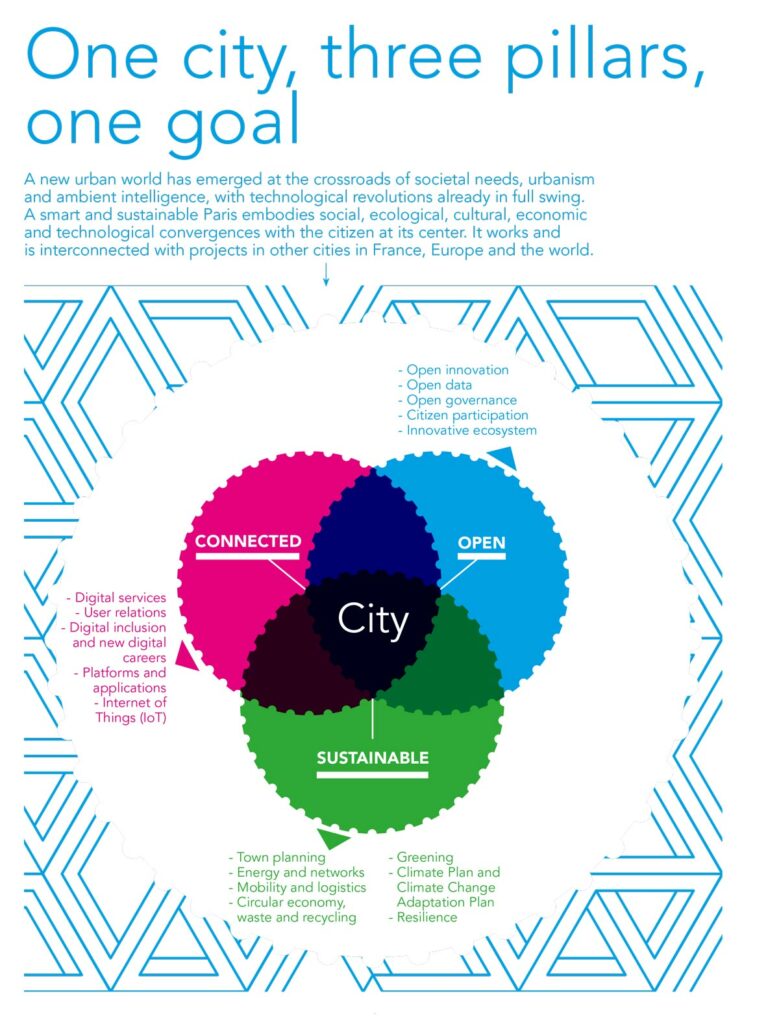Should cities strive to become ‘Sustainable Smart Cities,’ defined by the United Nations (UN) as “innovative cities that use “ICTs (information and communication technologies, editor’s note) and other means to improve quality of life, efficiency of urban operation and services, and competitiveness, while ensuring that they meet the needs of present and future generations with respect to economic, social, environmental as well as cultural aspects?”
Sure, if that is even remotely possible…
As the world population grows, so does the share that lives in cities (around 2.5 billion more people, for a total of 68% of the world population by 2050). Their size will grow too (the world is projected to have 10 more +10 million cities by 2030), which is anticipated to be a major factor leading to resource scarcity in the upcoming years.
“The surge in adoption of smart cities in multiple regions is driven by various government digital cities initiatives and rise in the need for better natural resource management in urban environments,” state Allied Market Research to explain why they forecast the smart cities market to keep growing at a CAGR (Compound Annual Growth Rate) of 25% until 2030, with the smart energy segment witnessing the highest growth in the upcoming years.
On paper, smart cities are a “game-changer”: “A tremendous amount of data is created every day in smart cities. After the data are collected, measured and analysed, knowledge is updated that will be further used to facilitate the decision-making process at the city level. This process creates a self-adaptive learning intelligent system for the smart cities to continually improve the social, economic and environmental issues for sustainable development,” explain ESCP Business School Professor Wei Zhou and his co-authors in the special issue of International Journal of Production Research on smart city sustainable urban logistics they co-edited.
A smart city may therefore be better prepared to respond to the more general challenges of sustainability than the traditional ones.
Wei Zhou

They view smart cities as ‘a novel paradigm’ for city planning and management, which modifies the mindset of the stakeholders related to city logistics, from municipal planners to citizens and service providers. “Real-time data are used to enhance performance, quality, optimise the interactivity of urban services, and to reduce resource consumption. A smart city may therefore be better prepared to respond to the more general challenges of sustainability than the traditional ones with a simple ‘transactional’ relationship with the citizens.”
Proof is abundant in existing smart city projects and pilots. Copenhagen, for example, is considered by some to be the most sustainable smart city in the world because of its innovative approach to collecting and using big data to make the city more environmentally friendly and improve the quality of life as well as the city’s business climate. It won the World Smart Cities Award in 2014 thanks to its project involving effective traffic solutions using data instead of huge infrastructural projects. Copenhagen Connecting uses data collected from mobile phones, GPS in buses, sensors in the sewers and even trash cans to decrease traffic congestion, air pollution and carbon emissions – “without turning the city into a big building site.”
Zürich’s smart building management system (heating, electricity, and cooling are all integrated and maximised) is supposed to reduce energy consumption by as much as 50%, and is one of the reasons it is considered the most sustainable smart city in the world by Sustainability Magazine.
Digital solutions for a more livable future
According to a recent study by the McKinsey Global Institute, Beijing reduced deadly airborne pollutants by roughly 20% in less than a year by deploying air-quality sensors, closely tracking the sources of pollution and regulating traffic and construction accordingly. “Overall, cities can save 25 to 80 litres of water per person each day and reduce unrecycled solid waste by 30 to 130 kilograms per person annually” by installing water metering that provides digital feedback messages to households, sensors and analytics to detect leakage from pipes, and using applications such as pay-as-you-throw digital tracking. Automation, systems, dynamic electricity pricing, and some mobility applications have the combined potential to reduce emissions by up to 15% and commuting times by 15 to 20% on average.
Selling mobility data and the services required to share and use it is a big and growing market.
Louis-David Benyayer

All data-related endeavours come with challenges, however: “Last spring, I carried out a market study with colleagues from MobiDataLab, the EU-funded lab for prototyping new mobility data-sharing solutions,” recalls Louis-David Benyayer. In his blog, he explains that “selling mobility data and the services required to share and use it is a big and growing market.” This applies to CO2 emissions reporting, which is both used to understand where there is the greatest potential for reducing emissions as well as for comparing different planning choices.
“Understanding emission-related data is needed for a more sustainable planning of transports, both for people and freight,” note the authors of the Market Gap Analysis Report. “Besides the environmental impact that the increased awareness will raise, this UC [use case] may lead to business opportunities for stakeholders involved.” However, they also identified gaps and issues in the current market of transport data, such as “heterogeneity of data sources leading to difficult data aggregation and comparability; mobility data availability and accessibility; lack of standardization models and data anonymization tools; low understanding of the business value that data sharing would favour.”
‘Linking Cities’ are the new smart
Some other challenges were made obvious when Sidewalk Toronto – an urban development project proposed by Google subsidiary Sidewalk Labs – was cancelled, officially “due to the unprecedented economic uncertainty brought on by the Covid-19 pandemic.”
“The failure of Sidewalk Labs forces us to invent other models for the cities of tomorrow, more inclusive ones, and in which data would not be considered as economic resources naturally available to multinationals but would be the object of collective reflections. This means producing and using data selected for the priorities they can serve (environmental for example) and in conditions that allow voluntary and fruitful exchanges for all,” commented Ben Voyer, Gérard Naulleau and the other members of the Netexplo Smart Cities Accelerator observatory in French economic newspaper Les Echos.
The intelligence – or smartness – of cities lies in its citizens more than in the dry use of technology.
Ben Voyer

“Smart-city projects became tech-ruled, rather than citizen-ruled. Projects were designed and promoted as ‘better lifestyle’ initiatives, but the voice of citizens was often put in the background”, adds Ben Voyer. “In reaction to this, the concept of Linking Cities emerged during the 2021 UNESCO Netexplo Forum to promote the idea that the intelligence – or smartness – of cities lies in its citizens more than in the dry use of technology.”
Rather than smart cities producing economic value through data extraction alone, linking cities’ multiple values would be based on creating and maintaining links between inhabitants, territories, and environmental and social priorities. “This is an ambitious development. But it is necessary if the aims of cities’ transformation are not only technological but also environmental and human,” the members of the Netexplo Smart Cities Accelerator observatory add.
Smart&Open: the solution for more sustainable cities?
Let’s take the example of the City of Lights. Data is at the core of numerous solutions Paris started implementing in its quest to light the way by becoming a “Smart and Sustainable City”. This project proposes “innovative practices with regards to urban renewal and development, consumption (circular economy, energies, production flows, etc.), and network and mobility interconnectedness by using the methods of the ‘Open City’ (which some say is more realistic than the Smart City, editor’s note) and the tools of the ‘Connected City’.”
The city of Paris took a pioneering stance in open data policy, “making all structured data accessible by open license to promote their reuse and generate new applications back in 2010. The city also supports solutions for the analysis of big data, which is difficult to process with traditional tools but that can provide innovative solutions through new data science methods […] Lastly, the city promotes open innovation with its partners through data exchanges that are kept secure and confidential.”

Like Paris, cities of all sizes should definitely favour open data, open source, open science, open standards and open government practices, strive to become open smart cities, “where residents, civil society, academics, and the private sector collaborate with public officials to mobilize data and technologies when warranted in an ethical, accountable and transparent way to govern the city as a fair, viable and liveable commons and balance economic development, social progress and environmental responsibility…”
License and Republishing
The Choice - Republishing rules
We publish under a Creative Commons license with the following characteristics Attribution/Sharealike.
- You may not make any changes to the articles published on our site, except for dates, locations (according to the news, if necessary), and your editorial policy. The content must be reproduced and represented by the licensee as published by The Choice, without any cuts, additions, insertions, reductions, alterations or any other modifications.If changes are planned in the text, they must be made in agreement with the author before publication.
- Please make sure to cite the authors of the articles, ideally at the beginning of your republication.
- It is mandatory to cite The Choice and include a link to its homepage or the URL of thearticle. Insertion of The Choice’s logo is highly recommended.
- The sale of our articles in a separate way, in their entirety or in extracts, is not allowed , but you can publish them on pages including advertisements.
- Please request permission before republishing any of the images or pictures contained in our articles. Some of them are not available for republishing without authorization and payment. Please check the terms available in the image caption. However, it is possible to remove images or pictures used by The Choice or replace them with your own.
- Systematic and/or complete republication of the articles and content available on The Choice is prohibited.
- Republishing The Choice articles on a site whose access is entirely available by payment or by subscription is prohibited.
- For websites where access to digital content is restricted by a paywall, republication of The Choice articles, in their entirety, must be on the open access portion of those sites.
- The Choice reserves the right to enter into separate written agreements for the republication of its articles, under the non-exclusive Creative Commons licenses and with the permission of the authors. Please contact The Choice if you are interested at contact@the-choice.org.
Individual cases
Extracts: It is recommended that after republishing the first few lines or a paragraph of an article, you indicate "The entire article is available on ESCP’s media, The Choice" with a link to the article.
Citations: Citations of articles written by authors from The Choice should include a link to the URL of the authors’ article.
Translations: Translations may be considered modifications under The Choice's Creative Commons license, therefore these are not permitted without the approval of the article's author.
Modifications: Modifications are not permitted under the Creative Commons license of The Choice. However, authors may be contacted for authorization, prior to any publication, where a modification is planned. Without express consent, The Choice is not bound by any changes made to its content when republished.
Authorized connections / copyright assignment forms: Their use is not necessary as long as the republishing rules of this article are respected.
Print: The Choice articles can be republished according to the rules mentioned above, without the need to include the view counter and links in a printed version.
If you choose this option, please send an image of the republished article to The Choice team so that the author can review it.
Podcasts and videos: Videos and podcasts whose copyrights belong to The Choice are also under a Creative Commons license. Therefore, the same republishing rules apply to them.





